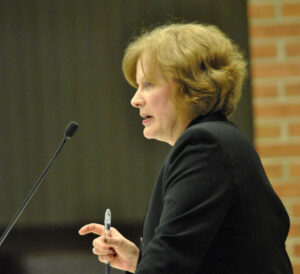
Judge Elizabeth “Libby” Hines
Judge Elizabeth “Libby” Hines presides over a specialized docket dedicated to domestic violence cases in Ann Arbor, Michigan. In 2009, she spoke with our director of communications, Robert V. Wolf, about her work. Her Q&A with Wolf is below. In 2018, she received the National Center for State Court’s William Rehnquist Award.
How did you come to preside over a specialized docket dedicated to domestic violence cases?
I was a prosecutor for 15 years, and I specialized in child protection cases and crimes against children. Over the years, I saw many domestic violence cases, and, as the second woman attorney ever in the Prosecutor’s Office, my boss would send me to different meetings with women’s groups and Safe House, our shelter for victims of domestic violence. So I had an opportunity to meet with a lot of people, and slowly but surely we changed policies and improved our handling of domestic violence cases.
In 1992, I was elected to district court, which is sort of the ER of the court system in our state. As a limited jurisdiction court, the cases include domestic violence, first and second offense, and aggravated domestic violence and stalking. Around 1996, I had a case where a person was convicted of domestic violence, ordered by a different judge to participate in what I felt was a great batterer intervention program, and then was back before me on a new charge. It turned out that the defendant had never gone to the batterer intervention program, and no one had ever told the previous judge. So I thought “That’s not going to happen again,” so I started doing reviews. By that, I mean I started bringing people back before me to show they were actually complying with court orders. That was the beginning of the domestic violence docket.
My colleagues were interested in doing the same thing, so we applied for and received funding from the U.S. Office on Violence Against Women, which chose us as part of its Judicial Oversight Demonstration Initiative. The funding, which ran for five years starting in 1999, allowed us so to set up specialized dockets, attend trainings, learn best practices, and create new forms. We have a very supportive group of police officers, the sheriff, the prosecuting attorney, judges, and defense bar who are interested in domestic violence issues and making our community safer, and we have a long history of working together. We focused on the limited jurisdiction courts such as mine because we had the lion’s share by far of the cases and we all worked together well and we all wanted to take baby steps, and use our best practices and spread them across the county, which is what we’ve done.
What’s a lesson you learned when creating your domestic violence dockets?
It’s critically important to bring in the defense bar early. My opinion is that no one favors domestic violence. You can disagree on what constitutes domestic violence or whether it happened in this particular case, but no one I ever met favors domestic violence. Given that, it’s so critical then to make sure that in the process of what we think is helping victims of domestic violence that we’re also being very careful to safeguard the rights of the defendants. And by including everyone—working together and meeting together regularly—we can develop good practices, hear concerns and address them both formally and informally.
How frequently do you hold your domestic violence docket?
We still have a regular docket of cases: landlord-tenant, parking, traffic, small claims, and other criminal cases. But one day a week, two of us three judges in the city of Ann Arbor and colleagues in other district courts in the county do domestic violence cases. And we coordinated our dockets so that the limited resources of the defense bar, the prosecutor, the shelter can staff our courts.
So all the judges don’t hear domestic violence cases on the same day?
Correct. We’ve minimized the overlap. And that was done by us working together and checking with dates that were good for everyone, including the other agencies.
And for you personally, is that one day a week that you’re handling domestic violence cases?
One day a week for pre-trials, judicial reviews, and sentencing. I do my trials at a different time.
Do most domestic violence cases involve misdemeanor charges?
The huge majority of cases are misdemeanors. We feel that if we do our jobs correctly at the beginning, it’s homicide prevention. By investing resources and really spending time at the misdemeanor level and giving an opportunity for a person to change if he or she wants to with some good programming and supports for victims, we think we can really make a difference and hopefully not have a felony case down the road.
What kind of outcomes have you seen over the years?
I think all of us absolutely believe that we’ve saved lives and have, in fact, made a huge positive difference. In terms of statistics, that’s our weak link, but I can certainly tell you stories. There was a presentation yesterday [at the Integrated Domestic Violence Court Open House sponsored by the Center for Court Innovation] by one of the New York judges, and his point was that numbers don’t really mean so much in this area.
I personally think it’s very difficult to decide how you measure success. You can look at recidivism; I think very few people come back. You can look at domestic homicide, which I believe we’ve reduced. Definitely fewer cases are dismissed. And I think there’s much more satisfaction at the end of a case among both defendants and victims. I bring people back at the end and say “You’re off probation. You can say anything you want.” And almost to a person they say they went kicking and screaming into the 52-week batterer intervention program. They hated it. And now they say they wish they’d had the information earlier. They think it should be taught in school. If so, they would never have been here. They have such positive things to say.
The judge from New York was saying he looks at cases as helping one family at a time. And I guess I’m a big believer in that—that maybe we should learn more from our anecdotes and stories rather than pure numbers because it’s really hard to measure what worked and what didn’t work.
What are some of the takeaways you’ve gotten from your three days here at the Integrated Violence Open House?
I believe we can always do better, and that’s why working with the Center for Court Innovation and hearing new ideas from other jurisdictions and having the opportunity to see them in person, talk to the people involved, is so incredibly helpful. You walk away with new ideas, renewed energy. I’m anxious to go home and talk to my colleagues and see what we can do better.
One thing I’m taking with me is how important it is to get all the information you can possibly get to the judge. In the integrated domestic violence courts there is so much information, not only for the judge, who hopefully makes a better, fairer, more informed decision, but also information for the defendants and victims—from the defendant’s perspective, information that will help them not come back and not do something that could put them in prison, and from the victim’s perspective, information that enhances their safety and helps them make a more informed choice about what he or she should be doing.
If someone wanted to create a domestic violence docket or court, and you could give them one or two words of advice, what would you say?
I would tell them to look to people who have done it already. Site visits are helpful. Work with the Center for Court Innovation, the National Council of Juvenile Family Court Judges, the National Center for State Courts, the Vera Institute of Justice. Talk to judges that have implemented them. Why reinvent the wheel? Every jurisdiction is different and I don’t think you can generally pick up what works in one spot and take it to the other, but you can take ideas and go from there.
